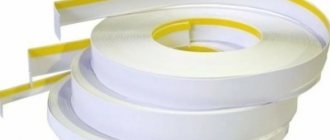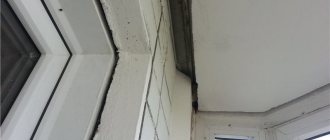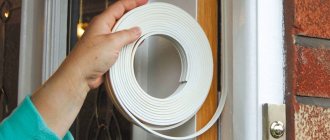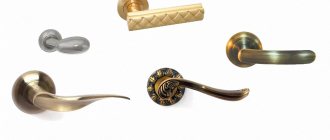Polyurethane foam is a polyurethane sealant enriched with compressed gas, which provides foam to the mixture. Foam is often chosen for installing interior doors. The substance quickly hardens, providing the necessary rigidity and strength of the box installed in the doorway. What foam to choose for installing doors in an apartment, what characteristics to look for when purchasing and how to use the product correctly, read on.
Types of polyurethane foam
Polyurethane foam is presented in two categories:
- professional - available in a cylinder with a ring valve for connection to a mounting gun;
- household - sold complete with a plastic tube that replaces the mounting gun.
Advantages and disadvantages of both varieties:
| Foam type | pros | Minuses |
| Professional |
|
|
| Household |
|
|
Depending on the application temperature, the sealant is:
- summer – not suitable for use at sub-zero temperatures;
- winter - retains its properties and hardens well even in frosts down to -20 ° C;
- all-season – does not impose requirements on ambient temperature.
Important! When using household foam, be aware of its high secondary expansion. If you apply too much sealant, the door frame may move after installation.
Why foaming?
Polyurethane foam is a sealing material that expands when applied. It has high adhesion rates to many surfaces, due to which it adheres well to vertical surfaces of wooden products, concrete, plaster, brickwork, etc. The foaming procedure when installing doors is required for several reasons:
- filling the gaps between the frame and the wall for further finishing and giving the opening an aesthetic appearance;
- sealing of joints, eliminating blowing, improving the thermal insulation and sound insulation of the room;
- additional mechanical fixation of the structure, ensuring reliability and solidity after installation.
Criterias of choice
When choosing installation material, pay attention to the following characteristics:
- Primary expansion - shows how much the mixture will increase in volume in the first minutes after spraying. For high-quality foam, this figure should not exceed 30%.
- Secondary expansion is an increase in mass in volume during the process of polymerization (solidification). The lower this parameter, the less the doorway will deform.
- The volume of foam at the outlet determines the material consumption (how much one cylinder will last). For professional products, the yield reaches 65 liters, for household products it does not exceed 40 liters.
- Adhesion is the ability of the mixture to stick to different surfaces that need to be foamed. For high-quality installation, high adhesion is required, which directly depends on the density of the sealant.
- Viscosity - determines the heat and sound insulation properties of the mixture. The higher the viscosity, the less heat and extraneous noise will penetrate through the doorway.
- Degree of shrinkage - the material should shrink minimally and hold its shape well. The acceptable parameter is 5% after secondary expansion.
- The rate of hardening determines the efficiency of construction work and the possibility of correcting sealing joints.
Acceptable standards for the basic characteristics of polyurethane foam are given in the table:
| Technical Parameter | Norm |
| Consumption | For 1 linear meter of a doorway with a seam depth of 5 cm and a width of 2 cm - ⅕ part of a 65 liter cylinder. |
| Drying time | Initial polymerization – up to 3 hours, final – no more than 12 hours. |
| Adhesion | From 0.19 to 0.48 MPa in relation to concrete surfaces. |
| Fire resistance limit | Up to EI360 – withstands heating from direct fire (temperature up to +1000 °C) for 6 hours. |
| Best before date | From 12 to 18 months. |
These are average indicators that depend on the installation conditions of interior doors. For example, material consumption increases at low air temperatures, and adhesion on brick, concrete and wooden surfaces will be higher than on plastic ones.
Important! Before use, the bottle of foam must be kept at room temperature for 12 hours, and before spraying, shake vigorously for at least 20 seconds.
Which brands of polyurethane foam have the best characteristics:
- Penosil – the line includes drugs for professional and household use;
- Soudal - sealants work well at low temperatures and have low expansion;
- Tytan - foam has high thermal insulation properties and is consumed economically;
- Illbruck are professional products for summer and winter use with high fire resistance.
Results
Polyurethane foam is a convenient and lightweight tool for installing window doors and other critical structures. Main important points:
- it may consist of one or two components. Its properties, price, and operating parameters directly depend on this;
- To install the door, you need to fix it correctly, check the angles and levels;
- It is not necessary to use a gun, however, it will help to easily dose the foam and make the connection more accurate;
- Commercial all-purpose foams should be avoided as they will not provide the desired effect. If you perform the installation in the summer, use summer foam, in the winter, winter foam.
vote
Article rating
How to determine a quality product?
You can understand that this is a high-quality polyurethane foam container in front of you by the following signs:
- Packing condition . The cylinder must be intact, without dents or visible damage. Only complete packaging guarantees the preservation of the high chemical and performance properties of the mixture.
- Best before date . It is not recommended to buy sealant with an expiration date. There should be at least 2-3 months left before the end date - the fresher the foam, the more reliable the installation.
- Uniformity of composition . To check, just turn the container upside down and shake it several times. Its contents should flow smoothly, without sudden impacts characteristic of dried sealant.
- Color . Can only be determined after opening the package. A high-quality product has a light beige tint, and a dark color is a sign of polymerization of the composition.
The average weight of a cylinder that contains a high-quality undiluted mixture should be about 910 g. This corresponds to 750 ml of foaming agent.
Pistol selection
Professional grade foam can only be used with a gun.
This is a special nozzle that helps fill cracks and voids after installing an interior door. What criteria to rely on when choosing a pistol:
- Material (metal or plastic). Plastic nozzles are cheaper, but metal ones are considered more durable and easier to clean from residual foam substances.
- Construction . Collapsible, reusable models are valued more highly. Disposable nozzles cannot be effectively cleaned of foam, so after use they are immediately disposed of.
- Nozzle size . Selected according to the volume of cavities that need to be blown out. The smaller the gap, the smaller the “caliber” of the gun should be.
When purchasing, you need to evaluate how comfortable it is to hold the nozzle in your hand, and whether the supply of sealant is easy to adjust.
Properties and types
Polyurethane foam is a polyurethane one-component sealant. Its popularity is enormous: without it, the process of installing doors and windows becomes noticeably more complicated, and it becomes impossible to carry out professional work directly related to repairs. The use of such a sealant does not require the purchase of secondary tools for work. The liquid material enters all the necessary cavities and dries completely after a certain amount of time. Polyurethane foam is always supplied in the form of cylinders containing liquid prepolymer and propellant gas.
When the contents of the cylinders are released, a polymer reaction occurs. The humidity of the air and the substrate being sealed is responsible for their release.
How to install an interior door on foam
To install the frame with the door leaf, first dismantle the old door, prepare tools and consumables.
To work you will need:
- polyurethane foam with a spray nozzle;
- level for correcting the position of the door frame;
- screwdriver;
- drill with a thin drill bit;
- roulette;
- door hinges;
- screws, self-tapping screws or anchor bolts.
Step-by-step instruction:
- Assemble a new door frame - connect the pillars together using self-tapping screws and a screwdriver.
- Install fittings. If the door block will be attached with hinges, they are first secured to the frame and then screwed to the wall.
- Mark the bottom of the door leaf, leaving a gap of 1-2 cm between the door and the floor. If the floor is uneven or you plan to lay flooring in the future, the door is raised higher and secured with wedges made from scrap materials.
- Place the frame in the doorway, carefully aligning it horizontally and vertically. The door must remain motionless in three positions - open, half-closed and closed.
- Screw the fasteners to the wall, install the door hinges on top, trying to completely close the bolts.
- Fill the gap between the wall and the door block with foam, moving from bottom to top. The foam is applied in several layers, maintaining a break between fillings of 2-3 hours.
Advice! To speed up the polymerization of the foam, the cracks and adjacent areas of the box are moistened with water. Moisture will promote rapid hardening and improve surface adhesion.
Dimensions of standard doors inside residential premises
Door sizes standardized according to GOSTs significantly reduce the cost of construction and solve many other problems. With appropriate openings, interior doors can be ordered wholesale in our store. Interior openings are usually smaller than the opening for the entrance door to a home. By the way, the width of the latter should be at least 80 cm, and for greater convenience - 85 cm.
Interior openings can be made 60, 70, 80 and even 90 cm wide. There is little point in openings that are too narrow: after all, you need to carry furniture, household appliances, musical instruments and other things through them. Therefore, when installing interior doors, it is advisable to choose a leaf with a width of 80 cm. Then, for example, a washing machine will fit into the opening without any problems (maximum dimensions in terms of 60x65 cm). The doors to the pantry can be made narrower.
The unified dimensions of doors (leaves) assume a pitch of 50 mm (sometimes 10-30 mm).
- For a door height of 1900 mm, widths of 550 and 600 mm are used.
- With a height of 2000 mm, the width is made 600, 700, 800, 900, 1200, 1400, 1500 mm.
- The following dimensions are less common: height 1940-2030 mm with a width of 630-760 mm and height 2040 mm with a width of 660-1600 mm.
It would not be superfluous to take into account the requirements of domestic GOST standards for the minimum dimensions of door openings. They are:
- For bathrooms - 550 (600) mm by 1900 (2000) mm with a depth of 50-70 mm.
- For kitchens - 700 mm by 2000 mm with a depth of 70 mm.
- For rooms - 800 mm by 2000 mm with a depth of 70-200 mm.
The standard depth of frames for interior doors is 75 mm. With thinner walls (for example, made of plasterboard), their thickness sometimes has to be increased for normal door installation.
Is it possible not to use fasteners?
Additional fastenings will not be required if you use only foam and wedges from scrap materials for installation. Pieces of thick cardboard or strong wood chips are suitable for these purposes.
Spacers are installed in the space between the wall and the door block in three places - at the level of the lock, upper and lower hinges. By analogy, wedges are placed on the opposite side of the opening.
The foam is applied in a thin layer on the outside and inside of the room. The spacers are removed from the gaps a day after foaming.
Installation of platbands
After the box is installed and the joints are sealed with foam, it’s time to attach the trim. They are nailed down. If these are frames made of fragile material, then drill holes in them before installation. This will prevent them from cracking.
All that remains is to remove the protective film and we can assume that the work of installing the door leaf is completed.
Fastening platbands
How to clean surfaces?
Chemical agents will help remove sealant from contaminated surfaces:
- Foam cleaners are produced in the same line as sealants and are suitable for both cleaning the gun and cleaning surfaces.
- Solvents – Acetone, White Spirit, Solvent 646 – effectively cope with fresh stains.
- Dimexide - a pharmaceutical product destroys the structure of polyurethane, removing it from various materials.
To soften the dried layer, you can use vegetable oil, water and vinegar. As soon as the sealant layer becomes pliable, it is cleaned off with a spatula or wiped with a rag.
Important! Test the chemical on an inconspicuous area that needs to be cleaned. If the surface is not damaged or changed color, you can safely use the product.
Wooden surfaces that are not coated with paint or varnish can be cleaned with a solvent. The sealant is carefully scraped off the varnished door with a knife and polished with sandpaper. Then the product is re-painted and varnished.
Remove foam from linoleum, laminate and parquet with a sharp object and remove residues with a special cleaner. The product should not contain acetone, otherwise matte marks will remain on the floor covering.
Do I need to trim dried caulk?
Dried foam spoils the appearance of the installed door, so the resulting sagging is removed after hardening.
This is allowed to be done no earlier than 24 hours after completion of installation. To work, you will need a construction knife with replaceable blades. The sagging is removed so that an even right angle is formed, and the level of the foam is level with the level of the walls.
If putty will be used for further processing of the seams, use a knife to slightly delve into the sealant, cutting off a few millimeters of thickness.
How to putty foam joints?
Putty is the best option for protecting foamed joints from moisture and ultraviolet radiation.
Primer mixtures are usually used in combination with putty - they are responsible for better adhesion of materials. Work progress:
- After cutting the foam, the seams are thoroughly cleaned of dust and debris.
- A primer is applied to the surface and the composition is allowed to dry - from 6 to 12 hours, depending on the composition.
- Mix the putty according to the instructions and apply the starting layer. The leveling coating must be dense to mask all defects.
- After 20 minutes, apply the finishing layer, trying to achieve a smooth finish.
When the finishing layer is completely dry, it is sanded with fine-grained sandpaper and treated with a primer. Now you can paint the slopes or cover them with wallpaper.











